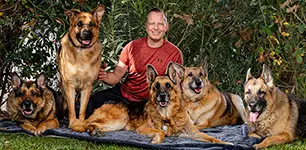
Clarity matters! Clarity matters in communicating with your dog, training your dog, and living with your dog harmoniously.
Not much enrages the temperaments of dog trainers more than arguing about the true nature of dogs. One would think that we had settled this argument by now, but clearly, we haven’t. And while we probably have as many opinions as we have dog trainers, most viewpoints fall on the spectrum of two major camps. I call them the “pack leader” and the “cooperative partner” groups.
Two Main Trainer Groups
I used to be in the former and am now in the latter. There are many reasons why I changed my views over the last eighteen years. My earlier opinions made sense to me at the time. But they were not as informed as my opinions are today. I have gained more clarity. I don’t view this as a past failure; I view it as growth. If I didn’t change my views upon gaining a deeper understanding, I would not be true to myself. We should always be open to reevaluating our opinions and modifying them in the face of better information.
I can’t take full credit for everything I will share in this article. I don’t remember which views I adopted from whom over the years. Still, people who have influenced my thinking significantly are Chad Mackin, Jay Jack, Marc Goldberg, Martin Deeley, Michael Ellis, and, last but not least, Ivan Balabanov. There are others, but these are my key influences. In the past, I answered the question of my influences differently.
Reading, learning, and validating new knowledge through working with dogs for over a decade made me realize what was missing for me in the debate about dog’s nature; call it “the missing link,” if you will.
Different Approaches Work
We can find plenty of dog trainers and dog owner homes subscribing to the pack leader group’s thinking, organizing their homes and dogs accordingly; this works for them. Equally, we can find plenty of homes where this is handled differently, and dogs are treated more like family members in a cooperative setup; this also works.
If one camp was correct and the other was wrong, one of those groups should live in utter chaos or have miserable dogs. However, both approaches work equally if executed correctly. We also see both approaches fail miserably, which is why we all have jobs. However, this isn’t evidence of one side being correct and the other being wrong. This is simply a realization that humans have a great ability to screw anything up.
So, if both approaches can be successful, it stands to reason that both teams are doing something that makes it work, and it may not be what each of those groups thinks it is. What common denominator ultimately determines success or failure in living with dogs correctly or incorrectly?
In my view, it is clarity.
Clarity
Family dogs do best when they understand how everything in the home functions, how each family member interacts with them, and what each family member accepts and doesn’t accept in their interactions. How to have the best day at home? What leads to having the most fun every day? How to get food? How to get to play? And so on. Clarity about those things matters.
Competition dogs do best if they fully understand the picture of the obedience/routine they are asked to perform and how the path to the highest reward level looks. The phrase “understanding the picture” is frequently used in dog sports.
This is no different for people. We do best if we can predict the outcomes of our actions. And if we understand how we can influence our environment through our behavior toward others and the world. Dogs are the same. Clarity matters for all beings.
Clarity Through Structure
When people refer to being the pack leader, what are they saying? Cesar Millan called leadership protection and direction. And while in human terms, leadership is certainly defined differently, if we follow this definition, protection and direction both provide clarity to the dog. By telling a dog what to do, we are reducing choices and communicating what’s expected, including adverse consequences for non-compliance. This creates predictability for the dog. And what do rules, boundaries, and limitations accomplish? They communicate to the dog what is expected, what is not acceptable, and what is futile. The pack leader approach works because it provides clarity through structure.
Clarity Through Training
People in the cooperative partner group teach their dogs how to interact through training. We usually see more rewards in this setup. Good behavior is rewarded, and bad behavior is ignored, blocked, or punished. This provides clarity through teaching. The dog will learn what is expected through training.
It could be teaching traditional obedience commands or teaching the dog to make good choices at liberty. The latter concept doesn’t resonate with everybody yet, but the GRC Dog Sport, started by Jay Jack, will probably change that over the next couple of years.
Obedience training can provide clarity if the obedience is literal. Simply teaching interpreted obedience, as we see too often, won’t accomplish the clarity goal. The training of markers provides clarity. Taking the frustration out of the leash and collar through collar and leash conditioning provides clarity. Attention exercises that motivate your dog to maintain social connection and avoid him “checking out” provide clarity.
Clarity is the missing link. Whatever way you live with your dog, if your approach provides clarity, things will be okay. Every biological being functions better if the parameters and rules of maneuvering and influencing their environment safely are understood. Whenever a person or dog (or any other animal) does not understand how an environment functions, the results are stress and often frustration, which easily leads to aggression.
The Dog’s Experience Matters
Many different approaches can lead to a harmonious dog household if your dogs have clarity in their environment. However, I don’t think that is the only criterion that matter when it comes to training. The longer I train dogs, the more I care about their experience in training and keeping their overall stress level as low as possible in the long run.
As a result, my training has evolved from clarity through structure to clarity through training. Many of my behavioral cases involve both components, but the structural components are now on the low end, while the teaching component is on the high end. And in terms of structure, most of the time, that means creating a predictable routine in which I remove choices from the dog for a limited period.
Play the Audio





